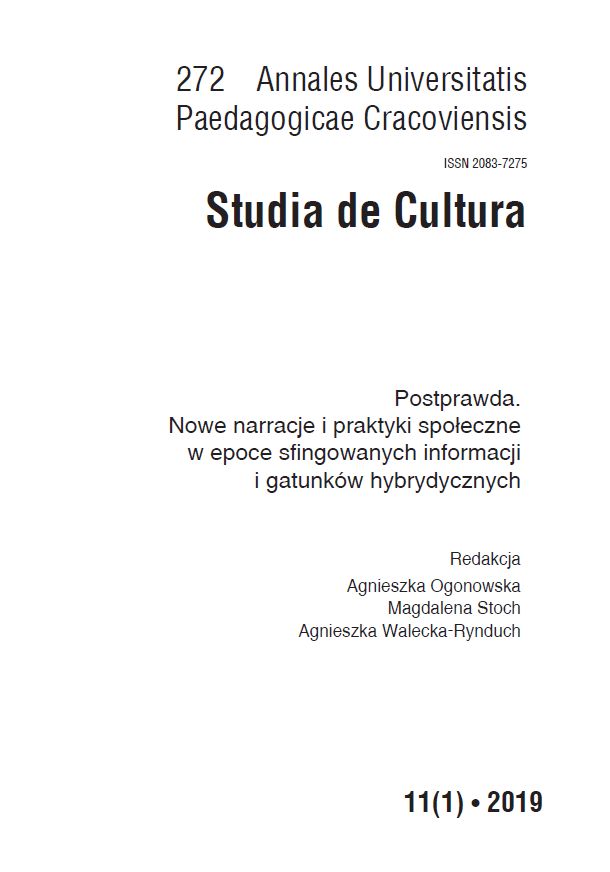Abstract
Children in toddlers and pre-school ages create a powerful group of media consumers and related media products in Poland and around the world (eg gadgets, toys, food products). At the same time, the audiovisual broadcast offer addressed to them is often not adapted to their cognitive abilities and social competences, although it is advertised as performing educational functions. On the basis of public and hidden advertising, children’s guardians make decisions about the purchase of specific products and services, also guided by their proof of social equity and their own convenience. Television and screens of various technologies for more than 30 years, from year to year, with greater intensity accompany the development of the child, also in the form of miniaturized and mobile. The analysis of specific messages in terms of their form and content allows to determine what audiovisual competencies are included in the ideal recipient’s project, postulated by the message. On this basis, it can be further determined which cognitive functions its understanding and interpretation requires, and in what relation the figure of the ideal recipient remains in relation to the real viewer. Research of this kind has a specific practical meaning, because it allows to effectively fight with double disinformation: in relation to carers and their charges. The first group is convinced that children have contact with messages tailored to their age, others often have such experiences in contact with the media, which do not at all serve their optimal cognitive, social, emotional and even negative results. The article refers to the first stage of the study of the understanding of audiovisual communications by children at the indicated stage of development and refers to the analysis of existing literature and partial own researchReferences
52-67.
Anderson Daniel R., Bryant Jennings. 1983. Research on Children’s Television Viewing: The State of the Art. W Children’s Understanding of Television: Research on Attention and Comprehension. D.R. Anderson, J. Bryant (red.). New York. 331-354.
Cieszyńska Jagoda, Korendo Marta. 2007. Wczesna interwencja terapeutyczna. Stymulacja rozwoju dziecka od noworodka do 6. roku życia. Kraków.
Cieszyńska-Rożek Jagoda. 2014. Wpływ wysokich technologii na rozwój poznawczy dzieci w wieku niemowlęcym i poniemowlęcym. W Człowiek. Technologia. Media. Konteksty kulturowe i psychologiczne. A. Ogonowska, G. Ptaszek (red.). Kraków. 11-22.
Eco Umberto. 1987. „Czytelnik modelowy”. Pamiętnik Literacki nr 78(2). 287-305.
Francuz Piotr. 2013. Imagia. W kierunku neurokognitywnej teorii obrazu. Lublin.
Francuz Piotr. 2002. Rozumienie przekazu telewizyjnego. W Psychologiczne badania telewizyjnych programów informacyjnych. Lublin.
Francuz Piotr. (red.). 2007. Obrazy w umyśle. Studia nad percepcją i wyobraźnią. Warszawa.
Francuz Piotr. (red.). 2007. Psychologiczne aspekty komunikacji audiowizualnej. Lublin.
Kołodziejczyk Anna. 2013. Media w życiu rodziny. Rodzaje mediacji i korzystania z mediów. W Współczesna psychologia mediów. Nowe perspektywy i problemy badawcze, A. Ogonowska, G. Ptaszek (red.). Kraków. 49-70.
Kołodziejczyk Anna. 2007. Znaczenie oceny realizmu przekazu dla rozumienia oraz efektów kontaktów z przekazem audiowizualnym. W Psychologiczne aspekty komunikacji audiowizualnej. P. Francuz (red.). Lublin. 13-36.
Kołodziejczyk Anna. 2010. „O odkrywaniu funkcji reklamy przez dziecko. Rozwój rozumienia perswazyjności i funkcji reklamy”. Psychologia Rozwojowa t. 15, nr 1. 75-88.
Lemish Dafna. 2006. Children and Television. Global perspective. Malden-Oxford-Victoria.
Nosal Czesław. 2004. Psychologia kompetencji w dobie nowej technologii informacyjnej. W Kompetencje medialne społeczeństwa wiedzy. W. Strykowski, W. Skrzydlewski (red.). Poznań.
Ogonowska Agnieszka. 2019. Edukacja medialna w kontekście cyberpsychologii: nowe perspektywy badania mediów i ich użytkowników we współczesnej cywilizacji medialnej (w druku).
Ogonowska Agnieszka. 2016. Komunikacja i porozumienie. Kraków.
Ogonowska Agnieszka. 2018. Współczesna psychologia mediów. Wprowadzenie. Kraków.
Ostaszewski Jacek. 1999a. Rozumienie opowiadania filmowego. Kraków.
Ostaszewski Jacek. (red.). 1999. Kognitywna teoria filmu. Kraków.
Patzlaff Rainer. 2008. Zastygłe spojrzenie. Fizjologiczne skutki patrzenia na ekran a rozwój dziecka. B. Kowalewska (przeł.). Kraków.
Spitzer Manfred. 2011. Cyfrowa demencja. A. Lipiński (przeł.). Słupsk.
Szubielska Magdalena, Francuz Piotr. 2004. Uwaga i rozumienie w odbiorze przekazu audiowizualnego przez dzieci. W Psychologiczne aspekty odbioru telewizji 2, P. Francuz (red.). Lublin. 219-243.
Tomasello Michael. 2002. Kulturowe źródła ludzkiego poznania. J. Rączaszek (przeł.). Warszawa.
Vasta Ross, Haith Marshall M., Miller Scott A. 1995. Psychologia dziecka. M. Babiuch (przeł.). Warszawa.
Wilk Eugeniusz 1989. Kompetencja audiowizualna. Zarys problematyki. Katowice.

